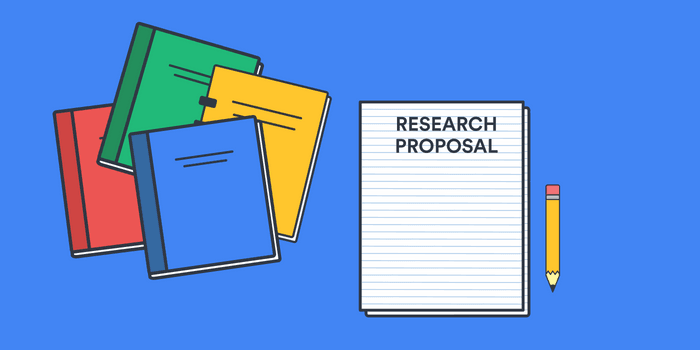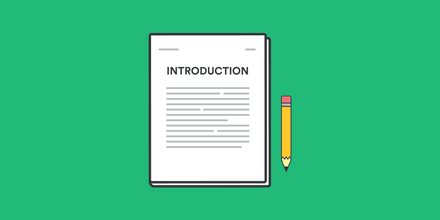
Writing classes often require students to submit a proposal before starting a research paper or other argumentative essay. What should you include in a research proposal? In this blog post, we cover the typical components of a research proposal and provide tips for getting started.
What is a research proposal?
A research proposal explains what issue or problem you plan to investigate for your research paper.
You may be required to submit a proposal to your instructor for approval before you start working on your actual paper. This ensures that you’ve chosen a defensible topic that warrants additional research and analysis.
Research proposals can be short, one-page documents that briefly explore your overall topic and argument or they may be more formal, multi-page assignments with distinct components. Your instructor may have specific guidelines for the proposal, so it’s always best to consult any available assignment details or rubrics before you get started.
What are the parts of a research proposal?
Most research proposals include multiple sections: a statement of the problem, an explanation of the purpose of the research, a tentative version of your thesis, a short literature review, a discussion of the methods and resources you will use, and a working bibliography. Let’s explore these components in more depth.
Statement of the problem
A statement of the problem is generally a 1-2 paragraph explanation of the topic or issue you would like to explore in your paper. In this section, you’ll want to provide enough explanation of your chosen topic to persuade your reader that it is an issue that needs to be addressed.
You might ask yourself the following questions as you’re constructing your problem statement:
- What specific issue do you wish to explore?
- What do you already know about this issue?
- Why is this issue significant or important?
Purpose of the research
In this section, you should explain the purpose of your research. For instance, what is your primary research question? What do you hope to accomplish through your research?
The purpose section helps you begin to answer the “so what?” question that you’ll need to address in your actual paper. Why would someone care about this topic and, more specifically, about your argument?
Tentative thesis statement
Although it’s not always required in a research proposal, your instructor might ask you to provide a tentative version your thesis statement. Typically, a thesis statement begins with some form of “I argue that…” or “This paper argues that…”
Your thesis statement may change as you conduct more research and begin to write your paper. However, including it in your research proposal allows you to test out your argument and see if it’s actually feasible.
Literature review
Although you won’t be expected to provide a complete literature review at this point, you should be able to offer some context for your topic, based on preliminary research.
In a few paragraphs, you’ll want to summarize a few major sources, explain why they are credible, and briefly explore how they may be used in your research paper. You’ll need to read each source carefully in order to provide an acceptable summary.
Remember to include in-text citations for any borrowed material that you use in your proposal. You can create accurate, proposal-ready citations with a citation generator like BibGuru.
Methods
The methods section should provide the reader with some insights about what resources you will use to conduct your research. You might highlight what search tools or databases you’ll use to find additional sources or you may wish to outline any primary research that you’d like to do (such as interviews or surveys).
Before you write this section, consider scheduling a research consultation with a librarian to identify helpful keywords or sources. Librarians can assist you with narrowing or broadening your argument and can help you locate relevant information on your chosen topic.
Working bibliography
Along with the text of your proposal, you should include a working bibliography, with references for the sources that you’ve consulted as part of your preliminary research. This is considered a “working” bibliography because it will very likely change by the time you submit your research paper.
Be sure to check with your instructor to find out which citation style you should use for your bibliography. You can also find useful citation examples and tips in our guides on APA, MLA, Chicago, and other citation styles.
Research proposal tips
Keep these strategies in mind to ensure that you write a successful research proposal:
- Use standard formatting like a 12-point font, one-inch margins, double-spacing, and correct title page.
- Provide clear explanations of the issue that your paper proposes to address and the purpose of your research. Use concise, concrete, and correct academic language.
- Show that you’ve carefully read your preliminary research through well-written summaries in the literature review section.
- Offer a clear and concise outline of your research methods. Discuss succinctly if you plan to conduct primary research like surveys and interviews.
- Double-check your bibliography to make sure that your references are complete and correct.
Frequently Asked Questions about how to write a research proposal
📀 What is a research proposal?
A research proposal explains what issue or problem you plan to investigate for your research paper. Its primary purpose is to convince the reader that your proposed project merits research and that your overall argument is feasible.
✳️ What are the main contents of a research proposal?
Most research proposals include multiple sections: a statement of the problem, an explanation of the purpose of the research, a tentative version of your thesis, a short literature review, a discussion of the methods and resources you will use, and a working bibliography.
🚣♂️ How long is a research proposal?
Research proposals can be short, one-page documents that briefly explore your overall topic and argument or they may be more formal, multi-page assignments with distinct components.
🥜 What is the most important part of a research proposal?
The most important part of a research proposal is the statement of the problem. This section provides key information about your topic.
🦈 What makes a good research proposal?
The most successful research proposals provide clear explanations of the issue that your paper proposes to address, the purpose of your research, and what methods or resources you will use to undertake your research. Good proposals also have correct formatting and citations.


